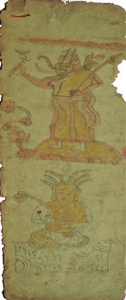
Venue: Jindřišská 27, Praha 1, second floor
Date: Sunday, July 1, 2018, 11am – 3pm
Speakers:
Charles Ramble (EPHE, Paris)
George FitzHerbert (EPHE, Paris)
Toni Huber (Humboldt Univerzität, Berlin)
Daniel Berounsky (FF UK)
Some texts related to Tibetan non-Buddhist ritual traditions can be found among the well-known documents from Dunhuang. Several unique old documents from the Gathang Bumpa stupa of south Tibet have been made available as well. Besides that, there are also a number of still little researched texts scattered among the authoritative collections of the monastic Bön. A number of non-Buddhist ritual texts emerged also from eastern Tibet recently and some research has been conducted on mundane ritual traditions in eastern Bhutan and Arunachal Pradesh. All these textual observed documents and rituals come from diverse locales and different times. Questions concerning their spatial and temporal relevance and their possible interconnection are thus of importance. Such rituals are seen as a part of the Bön tradition by the followers of the Bön themselves in some cases, but in other cases these are denigrated by the monastics of Bön as a heathen tradition alien to their own. Given the ambivalent meanings of the term Bön, such rituals are called “mundane rituals” here.
There is an emerging evidence that the eastern Tibetan traditions of such mundane rituals share some common features with those in Arunachal Pradesh and eastern Bhutan. Amongst others, they concern the frequent appearance of the mythical priest Ya-ngal, Wise Bat, Shenrab Miwo in his priestly form in the myths, or animals figuring in the myths and rituals: monkeys, badgers domestic fowl, pigs, bats – these are typical for the forested edge of the Tibetan Plateau. The latter two traditions can be also connected with similar elements appearing among Naxi, Pumi and other peoples of today’s Sichuan province, which have not been subjected to detailed research by Tibetologists so far.
These areas can be localised to a belt alongside the south-eastern edge of the Tibetan Plateau. The mentioned area stretches from the Cone (Co ne) up in the north-east running south through the Thewo (The bo), Phenchu (’Phan chu) and parts of Zungchu (Zung chu), then further through the areas inhabited by Naxi and Pumi peoples in Sichuan, down to the parts of Arunachal Pradesh and Eastern Bhutan.
The workshop is organised within a frame of the research project focusing on the Collection on Nyen(Gnyan ‘bum), which is a textual source apparently connected with this wider ritual tradition. It intends to put together a small group of scholars, who will discuss some pertinent questions related to the ritual traditions of the abovementioned area and some potentially promising directions for future research. There are number of unanswered questions related namely to:
- Language of the ritual texts and their unusual spellings
- Orality and the role it plays in the rituals
- Ritual performance
- Elements of the rituals and myths shared within the respective areas
- Process of transformation of local traditions into universal ones
- Relationship between such traditions of mundane rituals and monastic religions of Bön and Chö (Buddhism)


